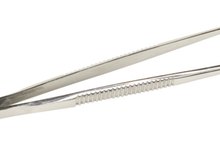How to Tell If I Did Not Remove the Whole Tick
The tick is a parasitic spider that burrows into the victim’s skin and sucks his blood, with only the body showing on the outside of the body. Both male and female ticks may bite a human being or animal. Spotting and removing ticks quickly helps reduce the chance of catching a bloodborne disease from them. Sometimes, when you remove a tick, its head or mouth parts may remain imbedded in your skin. They should be removed as well, using much the same technique that you used to remove the rest of the tick.
If you are experiencing serious medical symptoms, seek emergency treatment immediately.
Grasp the tick as close to your skin as possible with a pair of fine-tipped tweezers and pull it straight out; don’t twist it, and try not to crush it.
How to Get an Embedded Tick Out
Learn More
Inspect the tick that you pulled out 1. There is no neck to speak of on a tick, but its mouth parts do protrude between the two forward legs. There may be two or three mouth parts (ee Resources for some photos of common ticks). If the tick’s forward portion between the front legs is lacking obvious mouth parts, or if it’s not symmetrical, you probably didn’t get the entire tick.
Examine the bite area. You may need to do this under a bright light--a desk lamp will work if you have nothing brighter. Use your fingers to carefully spread the skin around the bite area, searching for any brown or black foreign matter that may still be embedded in the bite; that is the tick’s head or mouth parts. If you can't see the area clearly, use a magnifying glass.
How To Remove a Dead Tick
Learn More
Sterilize a needle or fine-tipped tweezers by soaking it in rubbing alcohol for about a minute, then carefully fish out any remaining parts of the tick’s head or mouth that may be embedded in your skin.
Related Articles
References
- Melissa Kapalan's Lyme Disease; How To Remove Ticks
- Centers for Disease Control and Prevention (CDC). Lyme Disease. CDC.gov.
- Centers for Disease Control and Prevention (CDC) staff. Tick Borne Diseases of the United States. CDC.gov.
- Centers for Disease Control and Prevention (CDC) staff. Overview of Tickborne Diseases. CDC.gov.
- Johns Hopkins Medicine, Rheumatology staff. What to do After a Tick Bite. Johns Hopkinsrheumatology.org.
- Mayo Clinic staff. Patient Care and Health Info. Tick Bites: First Aid. Mayo Clinic.org.
- Ostfeld, R. (2018) 8 Facts About the Ecology of Lyme. The Cary Institute of Ecosystem Studies. Caryinstitute.org.
- Zecken de Das Infoportal. About Ticks. Zecken.de.







